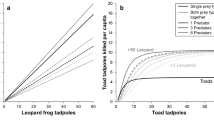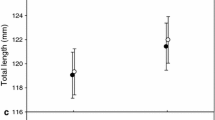Summary
Laboratory feeding experiments using Hesperoperla pacifica (Banks), Perlidae, and Megarcys signata (Hagen), Perlodidae, as predators and Baetis tricaudatus Dodds and Ephemerella altana Allen as prey indicate a strong effect of prey morphology and mobility and predator hunger on prey selection by stoneflies. Knowledge of both dietary composition and feeding behavior was necessary to fully understand prey selection by these stoneflies.
Fasted stoneflies presented with live prey ate more E. altana while satiated stoneflies ate approximately equal numbers of the two mayfly species. This pattern of dietary composition was the result of a reduction of attack frequency on the slower swimming E. altana with predator satiation and a continued high attack rate on B. tricaudatus regardless of recent feeding history. In contrast, fasted H. pacifica fed fresh frozen mayflies ate more B. tricaudatus indicating the importance of differences in prey mobility in controlling dietary composition.
The high degree of similarity in patterns of feeding and mechanisms underlying those patterns for H. pacifica and M. signata suggest that they may be using similar “rules” for choosing mayfly prey and we suggest that mayfly prey are ranked by stoneflies on the basis of handling times. A general mechanistic model for stoneflies feeding on mayflies is presented and discussed.
Similar content being viewed by others
References
Allan JD (1982) Feeding habits and prey consumption of three setipalpian stoneflies (Plecoptera) in a mountain stream. Ecology 63:26–34
Baumann RW, Gaufin AR, Surdick RF (1977) The stoneflies (Plecoptera) of the Rocky Mountains. Mem Amer Ent Soc 31
Brink P (1979) Studies on swedish stoneflies (Plecoptera). Opusc Ent Suppl 11:1–246
Cather MR, Gaufin AR (1975) Life history and ecology of Megarcys signata (Plecoptera: Perlodidae), Mill Creek, Wasatch Mountains, Utah. Great Basin Nat 35:39–48
Charnov EL (1976) Optimal foraging: attack strategy of a mantid. Am Nat 110:141–151
Cock MJW (1978) The assessment of preference. J Anim Ecol 47:805–816
Conover WJ (1980) Practical nonparametric statistics. John Wiley and Sons, NY
Dodds GS, Hisaw FL (1924) Ecological studies of aquatic insects. I. adaptations of mayfly nymphs to swift streams. Ecology 5:137–150
Edmunds GR Jr (1972) Biogeography and evolution of Ephemeroptera. Ann Rev Ent 17:21–42
Edmunds GF, Jensen SL, Berner L (1976) The mayflies of North and Central America. Univ Minn Press, Minneapolis
Fuller RL, Steward KW (1977) The food habits of stoneflies (Plecoptera) in the upper Gunnison River, Colorado. Envir Ent 6:293–302
Hassell MP, Southwood TRE (1978) Foraging strategies of insects. Ann Rev Ecol Syst 9:75–98
Hynes HBN (1971) The taxonomy and ecology of the nymphs of the British Plecoptera with notes on the adults and eggs. Trans Roy Ent Soc Lond 91:459–557
Ivlev VS (1961) Experimental ecology of the feeding of fishes. Yale Univ Press, New Haven
Johnson JH (1981) Food habits and dietary overlap of perlid stone-flies (Plecoptera) in a tributary of Lake Ontario. Can J Zool 59:2030–2037
Krebs JR (1978) Optimal foraging: decision rules for predators. In: JR Krebs, NB Davies (eds), Behavioral ecology an evolutionary approach, Blackwell Scientific Publications, Oxford-Melbourne, pp 23–63
Krebs JR, Cowie RJ (1976) Foraging strategies in birds. Ardea 64:98–115
Lechowicz MJ (1982) The sampling characteristics of electivity indices. Oecologia (Berl) 52:22–30
MacArthur RH (1972) Geographical ecology. Harper and Row, NY-London
Mackereth JC (1957) Notes on the Plecoptera from a stony stream. J Anim Ecol 26:343–351
Malmqvist B, Sjöström P (1980) Prey size and feeding patterns in Dinocras cephalotes (Plecoptera). Oikos 35:311–316
McCafferty WP (1981) Aquatic entomology. Science Books International, Boston
Minshall GW, Minshall JN (1966) Notes on the life history and ecology of Isoperla clio (Newman) and Isogenus decisus Walker (Plecoptera: Perlodidae) Am Midl Nat 76:340–350
Muttkowski RA, Smith GW (1929) The food of trout stream insects in Yellowstone National Park. Roosevelt Wildlife Ann 2:241–263
Pastorok RA (1980) The effects of predator hunger and food abundance on prey selection by Chaoborus larvae. Limnol Oceanogr 25:910–921
Peckarsky BL (1980) Behavioral interactions between stoneflies and mayflies: behavioral observations. Ecology 61:932–943
Peckarsky BL (1980) Aquatic insect predator-prey relations. Bio Science 32:261–266
Peckarsky BL, Dodson SI (1980a) Do stonefly predators influence benthic distributions in streams? Ecology 61:1275–1282
Peckarsky BL, Dodson SI (1980b) An experimental analysis of biological factors contributing to stream community structure. Ecology 61:1283–1290
Pyke GH, Pulliam HR, Charnov HL (1977) Optimal foraging: a selective review of theory and tests. Quar Rev Biol 52:137–154
Schoener TW (1971) Theory of feeding strategies. Ann Rev Ecol Syst 2:369–404
Sheldon AL (1979) Size relationships of Acroneuria californica and its prey. Hydrobiol 34:85–94
Sheldon AL (1980) Resource division by perlid stoneflies (Plecoptera) in a lake outlet ecosystem. Hydrobiol 71:155–161
Siegel S (1956) Nonparametric statistics for the behavioral sciences. McGraw Hill, NY
Siegfried CA, Knight AW (1976) Prey selection by a setipalpian stonefly nymph, Acroneuria (Calineuria) californica Banks (Plecoptera: Perlidae). Ecology 57:603–608
Snellen RK, Stewart KW (1979) The life cycle of Perlesta placida (Plecoptera: Perlidae) in an intermittent stream in Northern Texas. Ann Ent Soc Am 72:659–666
Tarter DC, Krumholz LA (1971) Life history and ecology of Paragnetina media (Walker) (Insecta: Plecoptera) in Doe Run, Meade County, Kentucky. Am Midl Nat 86:169–180
Vaught GL, Stewart KW (1974) The life history and ecology of the stonefly Neoperla clymene (Newman) (Plecoptera: Perlidae). Ann Ent Soc Am 67:167–178
Werner EE, Mittleback GG (1981) Optimal foraging: field tests of diet choice and habitat switching. Amer Zool 21:813–829
Author information
Authors and Affiliations
Rights and permissions
About this article
Cite this article
Molles, M.C., Pietruszka, R.D. Mechanisms of prey selection by predaceous stoneflies: roles of prey morphology, behavior and predator hunger. Oecologia 57, 25–31 (1983). https://doi.org/10.1007/BF00379557
Received:
Issue Date:
DOI: https://doi.org/10.1007/BF00379557




